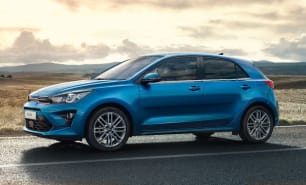Kias used to only be about cheapness. Remember the Mentor, Credos and Carens from about 25 years ago? Well, things have certainly changed!
And, more importantly, since then, the South Korean brand has not been afraid to take some mighty big swings.
Like with the Pro_Cee’d hot hatch, Picanto city car, later Sorento family SUVs, Stinger grand touring sports sedan and Carnival people mover. Some flopped, but all were met with critical acclaim, while today’s EV3, EV6 and EV9 SUVs are amongst the greatest electric vehicles of this or any era. All this from humble little Kia!
And the Tasman ute’s pricing, too, is ambitious.
All auto-only, the MY26 TK series kicks off with the two-wheel-drive (4x2) S from $38,010 (all prices before on-road costs) in Single Cab Chassis (SCC) and $42,990 Double Cab Pick-Up (DC P/U) guises.
Yep, only two 4x2 models exist in Australia for now.
The cheapest four-wheel drive Tasman is the S SCC 4x4 from $45,010, followed by the S Double Cab Chassis (DCC) 4x4 from $48,240 and S DC P/U from $49,990.
Equipment-wise, the Tasman S grade includes adaptive cruise control, dual-zone climate control, wireless Apple CarPlay and Android Auto, twin 12.3-inch instrumentation and multimedia displays, an integrated trailer brake controller and – on the DC P/U – a reversing camera, front and rear parking sensors and rear-bumper steps. But no standard bedliner.
These come up on top of the keyless entry/start, cloth seats, seven-year subscription to connected services with over-the-air updates, under-seat storage, lift-assist tailgate, a full-sized spare wheel and a range of advanced driver-assist systems (ADAS). More on the latter in the safety section below.
Going Tasman SX 4x4 in $49,520 SCC, $52,740 DCC and $54,490 DC P/U models means upgraded features like 17-inch alloys, a broader spread of ADAS, extra drive modes, sat-nav and powered folding mirrors.
From SX+ 4x4 and up DC P/U only, from $62,390. Aimed at private buyers, it ushers in 18-inch alloys, cloth/synthetic leather upholstery, rear-seat air vents, wireless charging, LED fog lights, ambient lighting, two 240-volt power outlets (including in the tub), a bedliner and more.
The X-Line 4x4 from $67,990, meanwhile, includes projector LED headlights, a column shifter to replace the T-bar shifter, paddle shifters, a nifty work table to make an AU Falcon fan’s heart swell, a 360-degree surround-view camera, synthetic leather, a powered and heated driver’s seat, even more ADAS safety, a reclining rear bench, privacy glass and side storage. This might be the sweet spot.
Finally, the X-Pro 4x4 from $74,990 is the Ranger Warrior-worrying range-topper, with all-terrain 17-inch tyres, a selectable rear locking differential, more off-road driving modes, a ground-view monitor, an off-road info screen and extra underbody protection, as well as a sunroof, vented front seats with memory, a powered front-passenger seat, heated rear seats, a heated steering wheel, premium audio and more.
Lots of kit for the cash then, but that’s Ranger Wildtrak V6 diesel money. And most grades are slightly more expensive than their Ford equivalents. This is no bargain-basement cheapie!
But… Kia believes the Tasman is priced accordingly, since it brings significant Australian packaging and engineering input, to a ute that is a slightly larger where it counts (except under the bonnet) than most of its rivals.
So, how involved has Kia Australia been in the Tasman?
The local outfit has been involved since the initial concept development stage five years ago, providing feedback, market research and even suggested the name.
The more important areas of influence and input include driving and ride dynamics, durability testing, towing performance, water-depth wading ability and seating-support parameters (being benchmarked against the Isuzu D-Max).
Kia Australia also helped shape the Tasman’s accessories, with 45 tailored and over 100 general items available from launch, with more expected later on.
These include varieties of bull bars (including full, single and bumper replacement), canopies, tonneau covers, side steps and trays, with the latter available in painted heavy-duty steel, as well as a tow bar, sports bar, extra storage, a bash plate and water tanks.
Work on accessories started way back in January 2022, with a prototype landing in Sydney two years later to commence over 30,000km of testing, including for waterproofing, dust proofing, vibration and fitment fatigue analysis.







